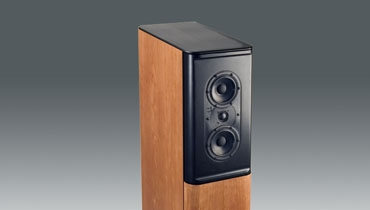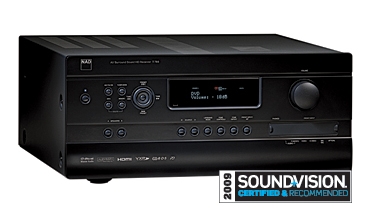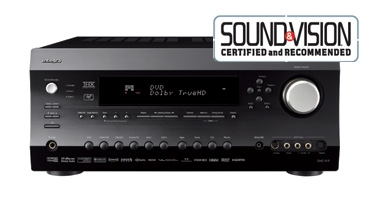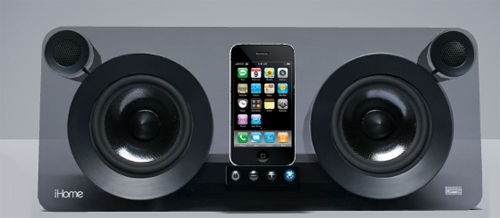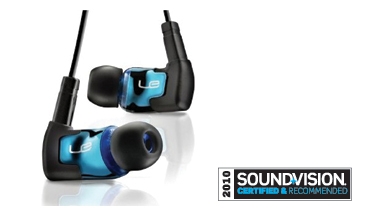2009 Editors' Choice Awards Page 4

REVEL CONCERTA M10, C10, AND M8 ON-WALL HOME-THEATER SPEAKER SYSTEM AND B120 SUBWOOFER
Flat TVs. Everybody wants one, lots of folks already have theirs, and most of those people also want "fl at" speakers to mount on the wall next to them. Lots of loudspeaker makers have hurried to oblige, and the result is a gallery of low-profile, reasonably capable wall-hanging speakers that look slick flanking an LCD/plasma set and sound pretty decent, too. Southern California high-end speaker maker Revel needed to satisfy its customers, too, but founder/ designer Kevin Voecks wasn't so okay with "pretty decent." The result is the Concerta HT family, which Voecks claims to have engineered from the ground up to compensate for the acoustical oddities of on-wall placement. The $3,999 dualsubwoofer Concerta HT system I reviewed ($2,999 with a single sub) is built on the same cabinet forms as sister brand Infinity's TSS line (both firms reside under the Harman International umbrella), but with entirely new drivers, crossovers, and layouts. And whatever Voecks's special sauce, the proof is in the listening: The Concerta HTs are the first on-walls I've encountered that can bear unapologetic comparison with high-end freestanding speakers on tonal accuracy, imaging cohesion, and dynamic honesty. They require very careful subwoofer-setup integration, and can come off as a little "dry" with harder-sounding recordings, but their spatial recreation with multichannel material, music and movies alike, and their ability to pump out clean, high levels (despite using 3-inch "woofers") are remarkable. And the price is no more than many a freestanding system of similar abilities. - Daniel Kumin
SNELL ACOUSTICS SIGNATURE SERIES C7 STEREO SPEAKERS
Big, heavy, and expensive, the Signature C7s ($9,000/pair) from Boston-area speaker crafters Snell Acoustics are a paragon of what high-end loudspeakers should be. They're about engineering as much as subjective creativity, with the credentials to back it: Snell's chief designer is Joe D'Appolito (of the widely used mid-tweeter/mid-driver array that bears his name), and the C7s employ extremely capable (and expensive), custom-specified European-made drivers. And as with every Snell speaker since the company's advent in 1976, the quality of their fine-woodworking cabinetry is unexcelled. Oh yeah, and they sound fantastic. The C7s deliver a ruthlessly honest, accurate tonal balance and rock-solid, razor-sharp stereo imaging, but with full-range musicality and the kind of dynamic potential and transient impact that induces besotted audiophiles to cheerfully spend 6 figures on amplification. They're also the sort of speakers that give rise to the idea that cheaper amplifiers don't "sound as good," because anything short of gobs of clean, stable, load-insensitive power with ample headroom simply won't cut it here. Very capable, very expensive, and very worth it. - D.K.
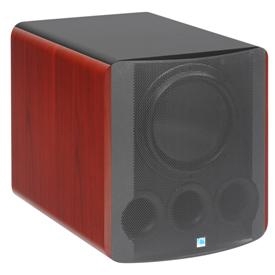
SVSOUND PB-12 PLUS SUBWOOFER
In our September 2009 issue's six-subwoofer shootout, the PB-12 Plus essentially tied two other models for first place - but it cost about half the price of one and two-thirds the price of the other. The PB-12 Plus ($1,149) delivers punch, power, and subtlety that only the very finest and most expensive subwoofers can equal, and we'd be hardpressed to cite a sub that can clearly surpass it. While able to reproduce the subtlest nuances of bass lines, kick-drum hits, and movie sound effects, it has so much muscle it can practically knock you back into your couch. Three pluggable ports let you fine-tune the bass to your taste. And an adjustable, single-band parametric equalizer evens out the sound by ridding your room of its most pronounced bass resonance. The PB-12 Plus makes no concession to interior design, though: Just witness its 21 x 19 x 25-inch footprint. - B.B.

PIONEER VSX-1019AH-K A/V RECEIVER
I could call the VSX-1019AH-K the Swiss Army knife of A/V receivers, but only a hack would use that tired cliché. So let's call it the Leatherman of A/V receivers. The $499 VSX-1019AH-K delivers audio-processing capabilities that few other home-theater products can match. Its MCACC technology automatically adjusts for flaws in the acoustics of your room. Even better, it's humble enough to hand the controls back over to you once it's taken its best shot. You can tweak MCACC's EQ settings for each channel and add other adjustments of your own. My favorite is the ultra-effective, super-simple X-Curve feature, which gently rolls off the treble to your taste. An included iPod/iPhone dock lets you browse your music collection on your TV screen, complete with cover art. For $499 you don't get the muscle or finesse of a high-end receiver, but you do get the processing power to improve your system's sound dramatically. - B.B.
NAD T785 A/V RECEIVER
In my book, NAD's new T785 ($3,999) comes as close to being the perfect A/V receiver as any I've used. It's not so much about power or features; it's the whole user experience. Modern A/V receivers have become so complex that creating one that is simple on the outside and ergonomically inviting while still delivering state-of-the-art performance can't be easy - which is perhaps why NAD spent some 3 years doing so. The T785 proved worth the wait. NAD's modular design allows for configurability and future upgradeability of video processing, audio DSP, and other key functions. Audio playback is powerful and dynamic far beyond the T785's modest specs (in the best NAD tradition), video processing is without visible shortcomings, and usability is without peer. The receiver's onscreen GUI eschews fancy color graphics, but the high-def sharp text displays come up instantly, and they're so well considered that after navigating menus during setup and regular use, you wonder why everybody else's are so damned busy, complicated, and confusing. A full suite of Audyssey DSP is onboard, as is an unspeakably useful preset scheme that lets you store three different "snapshots" of every important setting, adjustment, and option. There are omissions, to be sure - no media-streaming capability (so far) and only one HDMI output - and the T785's price is stern. But when the overall package is so very appealing, who cares? - D.K.
INTEGRA DHC 9.9 A/V PREAMP/PROCESSOR
It may seem an outrageous statement, but this $2,000 A/V quarterback from Integra (the premium label from Onkyo) might still be cheap at twice its price. The DHC 9.9 has all the latest tech on board, including plenty of HDMI v1.3a inputs and dual HDMI outputs; hi-rez audio-bitstream compatibility covering Dolby TrueHD, DTS-HD Master Audio, and SACD DSD formats; and the large helping of Audyssey DSP enhancements, including MultEQ XT auto setup/correction, Dynamic EQ, and Dynamic Volume, plus THX Loudness Plus. (You get to pick!) This THX Ultra2-certified pre/pro also offers extensive video-calibration controls courtesy of the ISF (Imaging Science Foundation, the de facto arbiters of high-end video), which can be individually confi gured by source input for both Day and Night viewing. None of this would matter if the Integra's video didn't look fabulous and its audio sound all but perfectly transparent - which they do. Just as important, the DHC 9.9's slightly clunky, slightly dated-feeling remote controller and straightforward (if a bit slow) onscreen menu systems are nonetheless easy and intuitive to use. If I was spending my own money on a pre/pro, this is what I'd buy. - D.K.
iHOME IP1 iPOD DOCK
First and foremost, let me congratulate iHome. There are more iPod/iPhone docks out there than you can shake a Zune at. And many of them are really quite good, providing a super-convenient way to access your music library in a stationary setting. In fact, the docks are so good, and so popular, that I've been seeing almost as many iPods used in home playback settings as in their native portable mode. Anyway, iHome gets major kudos for building the best one I've tested so far. The IP1 sells for a reasonable $300, has an amplifier rated at 100 watts, and sports a pair of 1-inch soft-dome tweeters and 4-inch woofers. Perhaps more important than what it has is what it hasn't. You won't find lots of buttons and dials, radio tuners and snooze alarms, or feature creep of any kind. Instead, this is a minimalist's dream of cool styling and no-nonsense operation. The dock and the speakers hover on a thick slab of smoky plastic, and the button count stops at 4. Since the build budget wasn't wasted on useless features, the designers were free to choose genuinely sweet speakers. These deliver warm, detailed sound as remarkable as the overall IP1 concept itself. Job well done. - K.C.P.
ULTIMATE EARS TRIPLEFI 10 IN-EAR HEADPHONES
Two years ago, my 2007 Editors' Choice picks included the Ultimate Ears UE11 Pro, a $1,150 pair of in-ear headphones with four tiny transducers in each of its custom-fitted earpieces, which just blew me away with its sound quality. So I wasn't surprised when UE's three-way TripleFi 10 ($400), the company's best "universal fit" model, rose to the top in the January 2010 issue's eight-model in-ear headphone comparison. There was some fine competition in that face-off , and the best of them presented a more refined tonal balance against the bass-rich response delivered by the TripleFi. But for its sheer dynamic impact and open, spacious imaging (for a headphone, anyway), the TripleFi was in a class by itself. My running notes during evaluation of these 'phones included this: "90% of UE11 at 1?3 the price." Need I say more? - R.S.
- Log in or register to post comments
